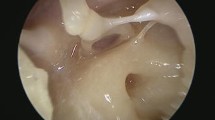Abstract
Purpose
To describe the in vivo vascularization of middle ear by an endoscopic point of view, particularly focusing on the medial wall of tympanic cavity and incudostapedial region (ISR).
Study design
Case series with surgical videos review and anatomical description.
Methods
48 videos from exclusive endoscopic middle ear surgery performed at the University Hospital of Modena from November 2015 to July 2017 were reviewed. Data about anatomy of vessels, and blood flow direction (BFD) were collected in an appropriate database for further analyses.
Results
48 cases were included in the present study. In 18/48 patients (37,5%), a clearly identifiable inferior tympanic artery (ITA) was present, running just anteriorly to the round window (RW), with a superior BFD (65% of cases) from the hypotympanic region toward the epitympanum. Some promontorial variants were described in 67% of cases and the most common finding was a mucosal vascular network with a multidirectional BFD. On the ISR, an incudostapedial artery (ISA) was detected in 65% of cases with BFD going from the long process of the incus (LPI) toward the pyramidal eminence in the majority of cases.
Conclusion
The vascular anatomy and BFD of the medial wall of the tympanic cavity can be easily studied in transcanal endoscopy. ITA (with a superior BFD in most cases) and ISA (with a main BFD from the incus to the stapes) are the most constant identifiable vessels.




Similar content being viewed by others
References
Yong M, Mijovic T, Lea J (2016) Endoscopic ear surgery in Canada: a cross-sectional study. J Otolaryngol Head Neck Surg 45:4. https://doi.org/10.1186/s40463-016-0117-7
Marchioni D, Soloperto D, Rubini A, Villari D, Genovese E, Artioli F, Presutti L (2015) Endoscopic exclusive transcanal approach to the tympanic cavity cholesteatoma in pediatric patients: our experience. Int J Pediatr Otorhinol 79(3):316–322
Marchioni D, Alicandri-Ciufelli M, Rubini A, Masotto B, Pavesi G, Presutti L (2016) Exclusive endoscopic transcanal transpromontorial approach: a new perspective for internal auditory canal vestibular schwannoma treatment. J Neurosurg 11:1–8
Bonali M, Anschuetz L, Fermi M, Villari D, Mariani GA, Manzoli L, Caversaccio M, Presutti L (2017) The variants of the retro- and hypotympanum: an endoscopic anatomical study. Eur Arch Otorhinol 274(5):2141–2148. https://doi.org/10.1007/s00405-4492-0
Anschuetz L, Bonali M, Guarino P, Fabbri FB, Alicandri-Ciufelli M, Villari D, Caversaccio M, Presutti L (2017) Management of bleeding in exclusive endoscopic ear surgery: pilot clinical experience. Otolaryngol Head Neck Surg 157(4):700–706. https://doi.org/10.1177/0194599817726982. Epub 2017 Sep 5
Lindeman H (1964) Some histological examinations of the incus and stapes with especial regard to their vascularization. Acta Otolaryngol Suppl 188(Suppl 188):319.
Anson BJ, Harper DG, Hanson JR (1962) Vascular anatomy of the auditory ossicles and petrous part of the temporal bone in man. Trans Am Otol Soc 50:21–32
Lannigan FJ, O’Higgins P, McPhie P (1993) The vascular supply of the lenticular and long processes of the incus. Clin Otolaryngol Allied Sci 18(5):387–389
Vallejo-Valdezate LA, Herrero-Calvo D, Garrosa-García M (2016) Vascularization of the long process of the malleus: surgical implications. Eur Arch Otorhinol 273(9):2335–2342.https://doi.org/10.1007/s00405-015-3787-2. Epub 2015 Sep 24
Gerlinger I, Tóth M, Lujber L, Szanyi I, Móricz P, Somogyvári K, Németh A, Ráth G, Pytel J, Mann W (2009) Necrosis of the long process of the incus following stapes surgery: new anatomical observations. Laryngoscope 119(4):721–726
Nager GT, Nager M (1953) The arteries of the human middle ear, with particular regard to the blood supply of the auditory ossicles. Ann Otol Rhinol Laryngol 62(4):923–49
Alberti PW (1963) The blood supply of the incudostapedial joint and the lenticular process. Laryngoscope 73:605–628
Colletti V, Sittoni V, Fiorino FG (1988) Stapedotomy with and without stapedius tendon preservation versus stapedectomy: long-term results. Am J Otol 9(2):136–141
Alberti PW, Dawes JD (1961) Necrosis of the lenticular process of the incus after stapes surgery and its treatment. A case report. J Laryngol Otol 75:821–825
Arnold A, Blaser B, Häusler R (2007) Audiological long-term results following stapedotomy with stapedial tendon preservation. Adv Otorhinol 65:210–214
Vallejo LA, Gil-Carcedo E, Herrero D, Sánchez C, Sánchez E, Gil-Carcedo LM (2007) Analysis of the mechanical-acoustic features of the middle ear after stapedial surgery both with and without stapes muscle preservation. Acta Otorrinol Esp 58(7):302–310
Rasmy E (1986) Stapedius reflex after stapedectomy with preservation of the stapedius tendon. J Laryngol Otol 100(5):521–527
Silverstein H, Hester TO, Deems D, Rosenberg S, Crosby N, Kwiatkowski T (1999) Outcomes after laser stapedotomy with and without preservation of the stapedius tendon. Ear Nose Throat J 78(12):923–928
Gros A, Zargi M, Vatovec J (2000 Dec) Does it make sense to preserve the stapedial muscle during surgical treatment for otosclerosis? J Laryngol Otol 114(12):930–934
Author information
Authors and Affiliations
Contributions
MAC: conception and design; data collection and statistical analysis; manuscript edition, revision and approval. FF: conception and design; data collection; manuscript revision and approval; PG, LA: conception and design; data interpretation supervision; manuscript revision and approval. LP, EMC: conception and design, senior supervision and critical revision of data analysis; manuscript revision and approval. All authors agree to be accountable for all aspects of the work in ensuring that questions related to the accuracy or integrity of any part of the work are appropriately investigated and resolved. MAC and PG had full access to all the data in the study and take responsibility for the integrity of the data and the accuracy of the data analysis.
Corresponding author
Ethics declarations
Conflict of interest
The authors declare that they have no conflict of interest nor financial relationship to disclose.
Research involving human participants and/or animals
This article does not contain any studies with animals performed by any of the authors.
Informed consent
For this type of study, formal consent was not required from local IRB.
Rights and permissions
About this article
Cite this article
Alicandri-Ciufelli, M., Guarino, P., Fabbri, F. et al. Middle ear microvascularization: an “in vivo” endoscopic anatomical study. Eur Arch Otorhinolaryngol 275, 889–894 (2018). https://doi.org/10.1007/s00405-018-4905-8
Received:
Accepted:
Published:
Issue Date:
DOI: https://doi.org/10.1007/s00405-018-4905-8




